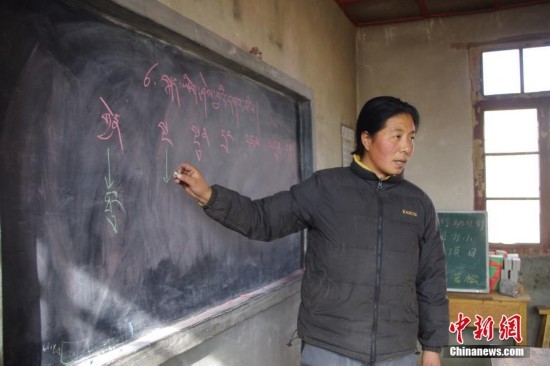Severe Teacher Shortages in NW China
china.org.cn / chinagate.cn by Zhang Ling, June 8, 2016 Adjust font size:
“After the nationwide rural ‘school merger’, a lot of primary school students have to climb mountains to go to schools far away from their own townships. Some children dropped out of classes due to long distance. In some areas, the aging of teaching forces has accelerated, coupled with an extreme lack of younger teachers. What’s more, some schools cannot afford stationery…many reports on this issue make faculties in the research project known as Satisfaction Ratings with Rural Basic Education in Northwestern Region deeply concerned.”
This eight-month research project was led by Youth League and the School of Education at Shaanxi Normal University (SNNU). Since June 2015, SNNU has joined hands with Northwest Normal University, Xinjiang Normal University, Qinghai Normal University, and Ningxia Normal University in conducting all-around research into the education of the northwestern region.
Under the guidance of experts, over 2,000 undergraduates visited nearly 100 counties along Shaanxi, Gansu, Qinghai, Ningxia, and Xinjiang and other areas along the Silk Road. While looking into over 400 grassroots level educational ministries and schools, they conducted the research program via multiple methods such as field trips, discussions and questionnaires.
“In general, the people in the northwestern regions are relatively satisfied with the development of basic education so far,” said Hao Wenwu, the chief expert on the project and a professor at SNNU, also adding that based on the 6,000 questionnaires, the satisfaction rate with the proportion of school-age children who receive education is 92.7 percent, the satisfaction level with teachers’ professionalism is 91.1 percent, and the satisfaction rating with school management, environment and safety is 90.5 percent.
However, the report also reveals many problems that primary and middle schools in the northwestern region are now facing.
The lack of teachers is most challenging. According to research, 63 percent of school masters believe that teachers are in very short supply, while 7.9 percent think that teachers are in severely short supply. This problem is more pressing for primary schools. Yet, 53.9 percent of teachers said that if they got a chance for career change, they would willing to leave their teaching post, among which 11.04 percent expressed a great eagerness to leave.
Taking primary school teachers in the Ningxia Hui Autonomous Region as an example, there were 33,357 teachers posted in 2014, a drop of 756 teachers compared to that of 2013. At the same time, the number of newly added teachers in 2014 was 6,555 with a decrease of 7,311 compared to that of 2013. “The natural decrease in the number of teachers far exceeds the number of newly hired ones.”
“What’s worse, teachers are not as passionate about teaching as they were before,” said Lu Shengli, the Deputy Party Secretary from SNNU, also stating that there was a gap between actual salary and expected ones among teachers, which is one of the most important causes behind this issue. In the research, 52.2 percent of the investigated rural teachers were somewhat dissatisfied, very dissatisfied, and neither satisfied nor dissatisfied with their income; while in county-level schools, this proportion rises to 72.2 percent. Meanwhile, in terms of living conditions, 45 percent of teachers in rural schools are somewhat dissatisfied, very dissatisfied, and neither satisfied nor dissatisfied. This rate reaches 47.5 percent in county-level schools.
In addition, many teachers are not content with the current promotion and training mechanisms. Some have said that schools tend to assess interior teachers but not hire exterior ones in arranging promotion and training opportunities, and most opportunities are distributed on the basis of school assignment and internal decision making, far from being fair to each player.
Rural school mergers have triggered problems as time goes by. The research shows that 48.9 percent of residents believed that the location and distribution of schools are neither good nor bad, 7.4 percent consider them unreasonable, and 0.8 percent of them think that they do not make any sense. Over half of them believe the distance between home and school is too long, and nearly 48 percent feel somewhat tired and very tired after travelling between home and school.



